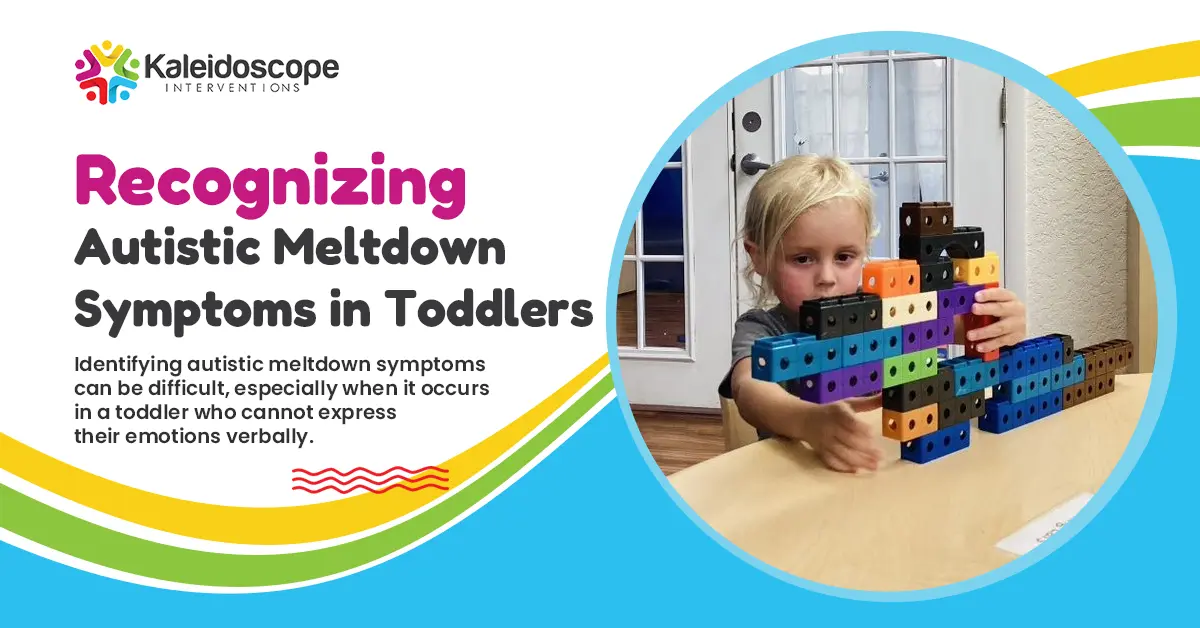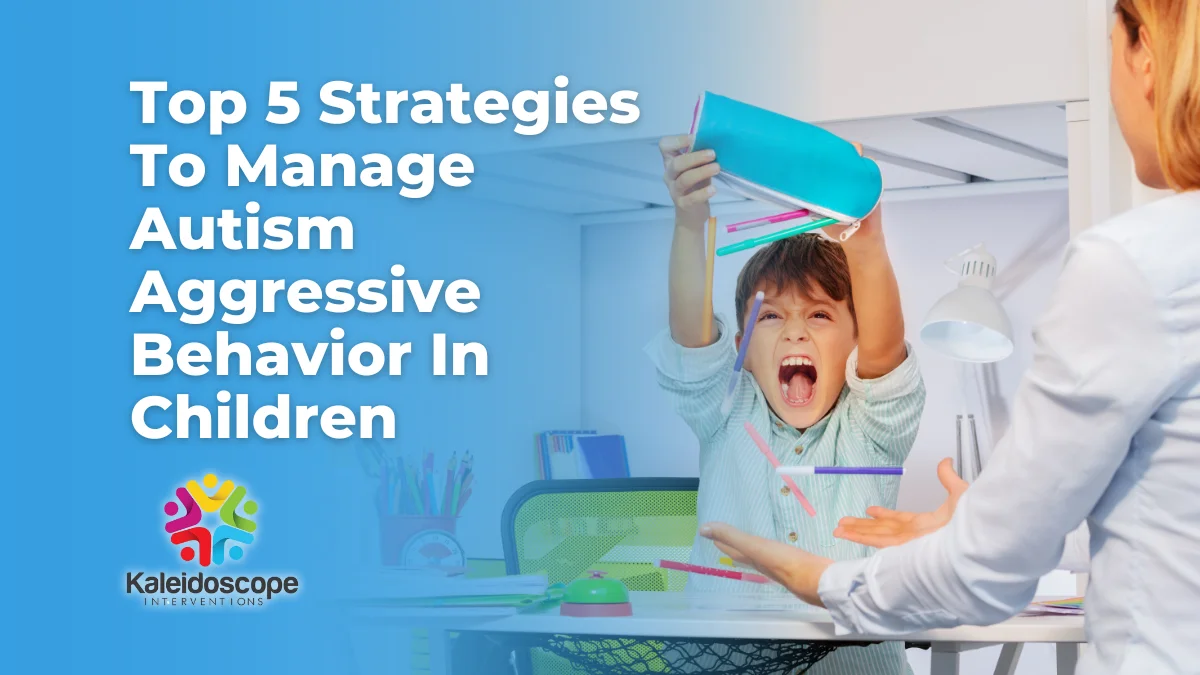Autism meltdowns in toddlers can be challenging for both the child and their caregivers. They are not tantrums; they are a response to overwhelming sensory stimuli, changes in routine, or frustration in communication.
Recognizing common signs and triggers, such as increased anxiety, avoidance behaviors, or repetitive movements, can help caregivers create a more supportive environment. Caregivers can foster calm and security by being proactive and patient, paving the way for positive developmental outcomes.
Recognizing Autistic Meltdown Symptoms in Toddlers
 Identifying autistic meltdown symptoms can be difficult, especially when it occurs in a toddler who cannot express their emotions verbally. However, understanding these signs can empower caregivers to offer appropriate support and reduce the severity of meltdowns. While every child with autism is unique, several common symptoms indicate an autistic meltdown:
Identifying autistic meltdown symptoms can be difficult, especially when it occurs in a toddler who cannot express their emotions verbally. However, understanding these signs can empower caregivers to offer appropriate support and reduce the severity of meltdowns. While every child with autism is unique, several common symptoms indicate an autistic meltdown:
Behavioral Indicators
Intense Crying or Screaming: Meltdowns often begin with sudden outbursts of crying or screaming that seem disproportionate to the situation.
- Aggressive Actions: This can include hitting, biting, or throwing objects. These actions are usually not directed at anyone specifically but are instead a result of the child being overwhelmed.
- Self-injurious Behaviors: Some toddlers might exhibit self-harming behaviors, such as head-banging or scratching when experiencing a meltdown.
- Repetitive Movements: Rocking, flapping hands, or pacing are common repetitive behaviors that may escalate during a meltdown.
Recognizing these behaviors can help parents and caregivers intervene before the meltdown reaches its peak.
Physical and Emotional Cues
In addition to behavioral indicators, physical signs may suggest a meltdown is imminent or occurring. These may include:
- Tense Muscles or Stiff Posture
- Clenched Fists or Teeth
- Rapid Breathing or Red Face
These physical cues can be paired with emotional responses like withdrawal, increased anxiety, or frustration, making it vital to monitor and address these signs promptly.
Understanding the Difference Between Tantrums and Meltdowns
To respond appropriately, it’s important to distinguish between tantrums and meltdowns. While tantrums often have a goal (e.g., gaining attention or an object), meltdowns respond to overwhelming stimuli beyond the child’s control. Meltdowns typically last longer; traditional discipline methods like time-outs may worsen the situation.
Strategies to Respond When Symptoms Appear
Once these symptoms are recognized, caregivers can take the following steps to manage and de-escalate the meltdown:
- Stay Calm: A calm demeanor helps reduce the intensity of the meltdown.
- Remove or Reduce Triggers: Identify and remove sensory or environmental triggers, if possible.
- Offer a Sensory Tool or Comfort Object: Sometimes, holding a familiar toy or using a weighted blanket can help the child self-regulate.
- Use Short, Clear Instructions: Provide simple directions in a soft voice, such as “Sit down” or “Take deep breaths.”
By recognizing autistic meltdown symptoms early and implementing these strategies, caregivers can create a safer and more supportive environment for toddlers experiencing meltdowns.
What Triggers Autism Meltdowns in Toddlers?
 Various internal and external factors can trigger autism meltdowns in toddlers. Understanding these triggers is essential for minimizing their frequency and intensity. While every child is unique, common triggers include sensory overload, routine changes, and communication difficulties. Parents and caregivers can better back their children during these challenging moments by recognizing what can set off a meltdown.
Various internal and external factors can trigger autism meltdowns in toddlers. Understanding these triggers is essential for minimizing their frequency and intensity. While every child is unique, common triggers include sensory overload, routine changes, and communication difficulties. Parents and caregivers can better back their children during these challenging moments by recognizing what can set off a meltdown.
Sensory Overload
Toddlers with autism often have heightened sensitivity to sensory inputs like sounds, lights, and textures. A busy environment with too much noise or bright lighting can quickly overwhelm them, leading to a meltdown. Common sensory triggers include:
- Loud Noises: Vacuum cleaners, sirens, or crowded spaces can be overwhelming.
- Bright or Flickering Lights: Fluorescent lighting or sudden flashes may cause distress.
- Uncomfortable Textures: Scratchy fabrics or unexpected textures like sand or certain foods can provoke a reaction.
Providing a quieter space or offering sensory tools like noise-canceling headphones can help reduce the impact of sensory overload.
Changes in Routine or Environment
Many toddlers with autism rely on routines to feel safe and secure. A sudden change—such as moving furniture, introducing new people, or altering daily schedules—can disrupt their sense of order, triggering a meltdown. Specific changes that may cause distress include:
- Unexpected Transitions: Abruptly moving from one activity to another without warning.
- New Environments: Entering a new location like a friend’s house, school, or public place.
- Alterations in Routine: A change in bedtime, mealtime, or even the order of morning activities can be unsettling.
To minimize this trigger, prepare the child for changes using visual schedules or social stories and maintain consistent routines whenever possible.
Communication Barriers
Toddlers with autism may have difficulty expressing their needs, wants, or discomforts. When they struggle to communicate, frustration can build up, leading to a meltdown. Common scenarios include:
- Inability to Express Needs: Not being able to ask for a specific toy, food, or activity.
- Misunderstanding Instructions: Confusion over what is being asked of them.
- Lack of Response from Others: Feeling ignored or misunderstood when communicating.
Communication tools like picture boards, gestures, or simplified language can help bridge the gap and reduce frustration. By identifying and understanding what triggers toddlers’ autism meltdowns, caregivers can proactively avoid or mitigate these situations, creating a more supportive environment that fosters emotional stability and development.
How to Deal with Autism Meltdowns Effectively
 Managing toddler autism meltdowns requires patience, preparation, and understanding. Meltdowns are not something a child can control, and punitive responses can often make the situation worse. Implementing strategies to handle these episodes can not only soothe the child in the moment but also help prevent future occurrences.
Managing toddler autism meltdowns requires patience, preparation, and understanding. Meltdowns are not something a child can control, and punitive responses can often make the situation worse. Implementing strategies to handle these episodes can not only soothe the child in the moment but also help prevent future occurrences.
Proactive Strategies for Preventing Meltdowns
Taking proactive steps to prevent meltdowns can significantly reduce their frequency and intensity. Some helpful strategies include:
- Creating a Sensory-Friendly Environment: Reduce sensory triggers by providing a quiet space, using soft lighting, and minimizing sudden changes.
- Visual Schedules and Social Stories: Use visual aids to prepare the child for transitions or new experiences. This helps set expectations and provides a sense of predictability.
- Offering Choices: Allowing the child to choose between activities or items gives them a sense of control and reduces frustration.
By being aware of the child’s sensory sensitivities and preferences, caregivers can create a setting that is more accommodating and less overwhelming.
Responding During a Meltdown
When a meltdown occurs, it’s essential to remain calm and supportive. Here’s how caregivers can respond effectively:
- Stay Calm and Offer Reassurance: Use a soft, soothing voice and simple words like “You’re safe” or “I’m here.” Avoid shouting or showing frustration.
- Minimize Stimulation: Reduce noise, move the child to a quiet area, and limit interactions until the child can calm down.
- Avoid Physical Restraint Unless Necessary for Safety: Physical restraint can escalate the situation unless the child is in danger of harming themselves or others. If restraint is necessary, use a safe and gentle approach.
- Use Sensory Tools: To help the child regain control, offer sensory items like a weighted blanket, favorite toy, or noise-canceling headphones.
- Provide Space: Sometimes, the child may need to be left alone (under supervision) to process their emotions.
Post-Meltdown Recovery
After a meltdown, the child may feel exhausted or disoriented. Take the following steps to support recovery:
- Offer Comfort: If the child is receptive, provide a favorite snack, drink, or cuddle time.
- Discuss When Ready: If the child is verbal, gently talk about what happened using simple language. Avoid blame or punishment.
- Reinforce Positivity: Encourage the child to regain control and let them know they are loved and supported.
Dealing with autism meltdowns effectively involves creating a safe, understanding environment and providing the child with the tools and support they need to manage their emotions. With patience and empathy, caregivers can help toddlers navigate these challenging moments more peacefully.
Supporting Parents and Caregivers
Caring for a toddler with autism can be physically and emotionally demanding. Supporting parents and caregivers is essential for ensuring they can effectively care for their children and maintain their well-being.
Encouraging Self-Care
Parents and caregivers often prioritize their child’s needs over their own, leading to burnout. Encouraging self-care practices—such as exercise, mindfulness, or taking time for personal hobbies—can help them recharge. Establishing regular “me time” is crucial for managing stress and maintaining mental health.
Building a Support Network
A reliable support network can create a significant difference. This can include:
- Family and Friends: Trusted individuals who can provide emotional support or help with childcare.
- Support Groups: Connecting with other parents who understand the unique obstacles of raising an autistic child can be empowering and validating.
- Professional Guidance: Therapists, counselors, or social workers can offer additional resources and advice.
Accessing Resources and Training
Providing access to educational materials, workshops, and training sessions can equip parents with practical strategies for managing meltdowns, improving communication, and fostering positive behavior. This helps them feel more confident and capable in their role.
Supporting parents and caregivers is not just about providing information but also about building a community where they feel valued, understood, and empowered to navigate the challenges of raising a child with autism.
Conclusion
A supportive and proactive approach can make a world of difference in managing aggressive autism behaviors. Parents and caregivers can create a setting where children feel safe, understood, and empowered by understanding the root causes, establishing consistent routines, using positive reinforcement, implementing sensory tools, and collaborating closely with therapists and educators. Every step forward, no matter how small, is progress toward a brighter future for children with autism.
At The Piece Fits, we’re committed to helping families navigate these challenges with compassion and evidence-based strategies. Ready to take the next step in supporting your child’s development? Reach out to our team today! Visit our contact page or call us at (321) 345-4232 to learn more about our services and how we can help your family thrive.


